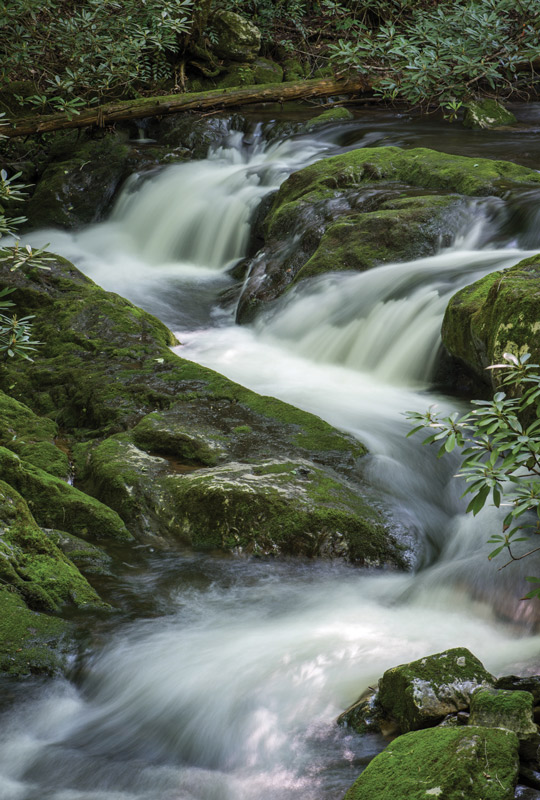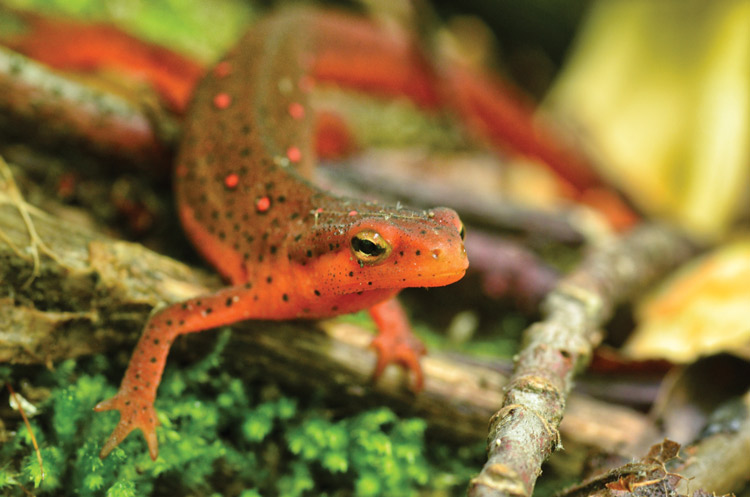In its new state park, Tennessee plans to build a large road on a steep mountainside, which would damage stream water quality and threaten wildlife.

The cleanest water, the rarest species, the most secluded hiking and biking trails in the region, and a new state park. You can find all this and more at Rocky Fork in the northeast corner of Tennessee. Now is the time to visit this remote and virtually undiscovered wilderness—and to help protect it.
Go to Mount Mitchell, highest peak in the east, in the late afternoon and look directly west: the mountains you see in the sunset comprise the Rocky Fork watershed. Or pick up the Appalachian Trail in the Smokies and hike northeast along the spine of the mountains that divide Tennessee and North Carolina for about four days, and you’ll come to Rocky Fork, a Smokies-like swath of forest that offers an ideal getaway for hikers, backpackers, mountain bikers, trout fishers, horseback riders, birders, and anyone simply seeking solitude in a pristine mountain setting.
Until you actually go “up in Rocky Fork,” it’s hard to understand just what a magical place it is. From the moment you enter the narrow passage that leads into a mossy-green-and-grey labyrinth of rock-strewn waterways, you are enchanted—even haunted—by an ancient energy force that is mysterious yet welcoming. It’s palpable and undeniable: this place has been special to people for centuries.
Rocky Fork is Appalachia at its very best. Part of Cherokee National Forest, the 10,000-acre Rocky Fork watershed is about the size of DuPont State Forest in Henderson and Transylvania counties of North Carolina. It adjoins the Bald Mountain Roadless Area, the largest area of its kind between Great Smoky Mountains and Shenandoah national parks. Its former owner was a timber company whose logging tracks crisscross the property in a network of unimproved, overgrown forest roads, ideal for hiking and exploring the remote backcountry. Many of these trails are suitable for mountain biking and horseback riding; some are only fit for foot traffic to protect the many fragile streams and springs.
“Surrounded by wilderness, national forest, and the A.T., the Rocky Fork tract has the potential to become a mecca for trail users with almost limitless options,” says John Beaudet, an A.T. thru-hiker, trail maintainer, and sawyer who moved to Flag Pond a decade ago to live near Rocky Fork. “A number of trails originate in the park and continue into the Cherokee National Forest. Some loop back to the park, and others traverse the remote backcountry connecting to the A.T. as well as to trails in the Sampson Mountain Wilderness. This allows for a wide range of choices—from short day hikes to longer loops that stretch day hikers’ limits to overnight backpacking trips with camping on Forest Service land.”
Who lives in Rocky Fork?
Unlike many people in other parts of the world, we in Southern Appalachia are fortunate that, in some places, we can actually find naturally occurring, clean water. Rocky Fork Creek has the cleanest water of any tributary in the Nolichucky River Watershed, which feeds into the French Broad and in turn feeds the Tennessee River, flowing all the way across the state and into the Mississippi.
Clean water contributes to healthy biodiversity—and it’s an important reason Rocky Fork has been inventoried and studied by scientists as a biodiversity hotspot. Its cove forest interlaced with pristine mountain streams is a bear sanctuary, home of the Southern brook trout, and a haven for salamanders including the Yonahlossee, hellbender and red-spotted newt. There are charismatic fireflies, a variety of frogs, bats, and delicate pink and yellow lady slipper orchids, among many other species.

Perhaps the most iconic species to make its home in Rocky Fork is the peregrine falcon, a raptor with a fabulous conservation success story. Brought back from the brink of extinction due to DDT poisoning in the 1950s and ’60s, literally hand-raised one at a time until viable populations were reached, this indomitable bird is now once again flying over much of its former range. A species that traditionally has not tolerated human disturbance, it seeks out remote, wild, unpopulated areas like Rocky Fork and can be seen near the watershed’s jagged cliffs.
New owner, new threat
Those who know Rocky Fork have likely read about how this “hidden jewel of the Blue Ridge wild” was saved a decade ago from developers who would have carved up the tract into lots for trophy homes. But the story doesn’t end there. This special place is under threat again, and this time the would-be developer is the state of Tennessee, which already owns a fifth of the tract, and created Rocky Fork State Park—renamed Lamar Alexander Rocky Fork State Park in January of this year.
While the 2,076-acre park is only a chunk of the 10,000-acre watershed, it provides the best point of entry for everyone who enjoys the entire tract, the rest of which was added to Cherokee National Forest. The small Rocky Fork State Park (RFSP) currently has no facilities and only limited parking. It is accessed via a narrow one-lane paved road, tightly wedged between the gorgeous Rocky Fork Creek on one side and steep-sloping embankments on the other.
The park’s iconic entrance is comprised of a field and wetland on the right, the spectacular creek in the center, and the steep slope of Flint Mountain arcing up from the creek on the left. Last November, after a three-year silence, Tennessee Department of Environment and Conservation (TDEC) announced plans to replace the natural entrance of the park with a modern visitor center and parking lot on the right, a new auto bridge over the creek, and a massive road cut into the steep slope of Flint Mountain for a two-lane, 24-foot-wide access road leading three quarters of a mile ostensibly to an overlook and primitive campground. What would this cost taxpayers? About $15,000,000.
“Before and after its establishment, Rocky Fork State Park was envisioned as a ‘primitive state park,’ one in which preserving the abundant natural and wild characteristics of the site would be paramount. It was to be a park that emphasized low-impact recreational use that included hiking, nature study, mountain biking, and hike-in camping,” says Dr. Foster Levy, an East Tennessee State University biologist who attended early stakeholder meetings about the park’s development, along with mountain bikers, equestrians, and representatives from the U.S. Forest Service, Appalachian Trail Conservancy (ATC), Unicoi County Commission, and TDEC. “Without exception, all supported the concept of a primitive, low-development park. None were in favor of road development within the park.”
Levy says the newly proposed visitor center would impinge on one of the few natural wetlands in the Rocky Fork tract. “This wetland supports the star-nosed mole as well as several noteworthy plant species. Runoff from the parking lot and other paved or graveled areas would flow directly into Rocky Fork Creek, increasing pollution and sediment.”
The site is also the breeding and hatching ground of blue ghost and synchronous fireflies. Lynn Faust of Knoxville has spent nearly three decades doing firefly research in the Appalachians, authored Fireflies, Glow-worms and Lightning Bugs, and created the system that scientifically predicts the peak of firefly activity in the Smokies each spring. While she says that “both Photinus carolinus and Phausis reticulata exist in other parts of the watershed, the proposed visitor center site is the most user-friendly spot for viewing since currently it is a sort of natural amphitheater where people do not have to tread on the actual areas the beetles emerge from in order to witness and enjoy them. Once earth moving and habitat destruction occur—followed by pavement, buildings, parking, heavy foot traffic, and lighting—the populations in this, the most ideal place to showcase the species’ displays to the public, would never recover.”

Small park, big road
The biggest problem would be the road up Flint Mountain, according to architect and rural resources planner Taylor Barnhill of Madison County, N.C. “Construction of the road is an engineering folly, an extreme waste of taxpayer money, and cannot avoid serious environmental damage,” he cautions. “Sediment and debris run-off into Rocky Fork Creek cannot be controlled under storm conditions. The steepness of this road—at 17 percent grade for much of the length—would be dangerous for any type of vehicle, especially RVs. Despite the statement that this road is not for an RV park ‘at this time,’ the future intent is clear to those who have followed this planning process from the beginning.”
Hugh Irwin, landscape conservation planner with The Wilderness Society, points out that “direct and indirect impacts of the visitor center and the proposed road could potentially impact many species found in the park, including state-listed species. They could also impact wetlands, stream water quality, and the primitive and natural characteristic of the park environment.”
Johnny Cosgrove of Tennessee Citizens for Wilderness Planning, an environmental advocacy organization based in Oak Ridge, Tenn., says the state’s current plans for Rocky Fork could cause serious damage to 15 streams, five springs, four wetlands, and three seeps within the project limits. Also in harm’s way are more than 70 plant and animal species within a four-mile radius of the project that are designated as endangered, threatened, of special concern, or in need of management—including the federally endangered Indiana bat and threatened Northern long-eared bat.
“The geology underlying the path of the proposed road is fairly unstable, and it also has the potential to seriously damage the aquatic life in adjacent creeks,” says Josh Kelly, public lands biologist at Mountain True, an Asheville-based conservation group that serves the Watauga, French Broad, Nolichucky and Pigeon River watersheds.
“There is a high risk of erosion, landslides, and slope failures due to the construction of the proposed road. Rocky Fork is an exceptional aquatic resource that should not be jeopardized by the development of a road meant to help people enjoy the very stream the road threatens.”
Rocky Fork needs your help
Our planet is now facing the sixth mass extinction of plants and animals in its history, according to the Center for Biological Diversity. Roads are one of the greatest impediments to habitat connectivity, which is necessary for wildlife to thrive. Four million miles of public roads cross the U.S. alone and kill roughly a million vertebrates every single day, according to the Wildlands Network.
“Rocky Fork is one of the last remaining pure wilderness areas in our region, definitely a wild place worth saving—again,” says Beaudet. “If there is any place on earth where we do not need another road, it’s here.”
In 2006, the Southern Appalachian Highlands Conservancy prepared the application for a $6 million grant from the Tennessee Heritage Conservation Trust Fund. Co-signed by the U.S. Forest Service, Appalachian Trail Conservancy, Tennessee Wildlife Resources Agency, and The Conservation Fund, the grant secured the majority of the money used to purchase the lands now comprising Rocky Fork State Park. “As a conservation organization, we share and celebrate the vision of Tennessee State Parks, which were established to protect and preserve the natural, cultural, and historic resources of Tennessee—promoting diverse recreation while conserving the natural environment. Rocky Fork is a regional treasure and affords an opportunity to provide a unique park experience,” says Carl Silverstein, Southern Appalachian Highlands Conservancy’s executive director. “Rocky Fork’s best feature is its solitude, its adjacency to other protected land, and access to a backwoods recreation experience. We believe that with careful planning and promotion, this minimally developed park can become a cultural and economic driver for Unicoi County.”
Dr. Levy says those involved in the early stakeholder meetings favored private development of campgrounds, accommodations, and restaurants in the area surrounding the park to spur economic development in the county. In a 2014 steering committee meeting, Levy presented a plan for electric vehicles to transport visitors to the park features, “eliminating the need for wide, paved roads and minimizing environmental impacts while providing access to members of the public unable or disinclined to walk. These electric vehicles could be run as a privately operated concession that would draw visitors and preserve the fragile watershed at a fraction of the cost of the newly proposed 24-foot-wide road.”
Barnhill believes that charging in-park fees and sending visitor dollars to Nashville would only hurt the local economy. “With half of its resources in public lands, Unicoi County should serve as a gateway community to those lands. As such it has the potential for significant economic development through private businesses that would support visitation to RFSP and the Cherokee National Forest.” He adds that the state could greatly enhance those efforts by partnering with Unicoi County to support development of private enterprise like RV campgrounds on private land.
“This park does not yet have a comprehensive management plan that considers future uses and stakeholders. No road, visitor center, or campground should be built without this plan and without first considering building the infrastructure on property adjoining the current park boundaries,” says Cosgrove. “If properly managed as a rustic state park, and protected through low-impact, eco-conscious development, Rocky Fork can remain one of the last pristine wildlife refuges in Southern Appalachia.”
What you can do
Those who do not want to see Rocky Fork over-developed are following the next steps, which will likely include a permitting process for the road-building project, followed by a public hearing and a 30-day period for public comment. Many more voices are needed to be able to protect Rocky Fork.
Learn more about Rock Fork and what you can do to help at the Rocky Fork Journal web site and the Rocky Fork Watershed Almanac Facebook page.
Frances Figart is the Interpretive Products and Services Director at Great Smoky Mountains Association. The views expressed here are her own and not those of GSMA or GSMNP.







